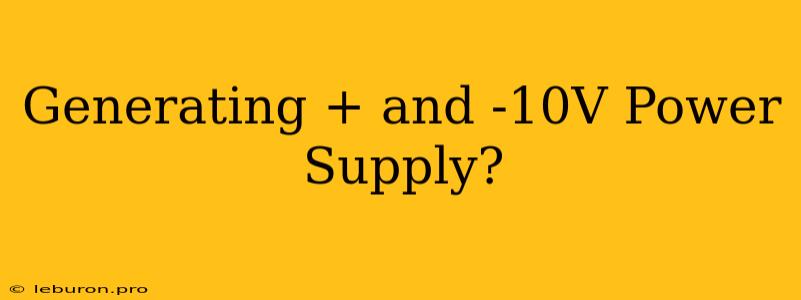Generating a ±10V power supply is a common requirement in various electronic circuits and systems. This power supply configuration provides both positive and negative voltage rails, which are essential for operating operational amplifiers, analog-to-digital converters, and other circuits that rely on bipolar voltage swings. In this article, we will delve into the different methods for generating a ±10V power supply, exploring their advantages, disadvantages, and practical considerations.
Methods for Generating a ±10V Power Supply
There are several methods for generating a ±10V power supply, each with its own advantages and disadvantages. The choice of method depends on factors such as the required output current, accuracy, and available components.
1. Dual-Output Power Supply
A dual-output power supply is a dedicated power supply that provides both positive and negative voltage rails simultaneously. These power supplies typically use two independent voltage regulators, one for the positive rail and one for the negative rail.
Advantages:
- Simple and straightforward: The dual-output power supply provides a straightforward solution, requiring minimal external components.
- Good regulation: The dedicated voltage regulators ensure good voltage regulation, maintaining stable positive and negative voltages.
- Widely available: Dual-output power supplies are readily available in various voltage ratings and current capacities.
Disadvantages:
- Cost: Dual-output power supplies can be more expensive than other methods.
- Limited flexibility: These power supplies are fixed to the specified voltage ratings and current capacities.
2. Voltage Doubler Circuit
A voltage doubler circuit uses a combination of capacitors and diodes to double the input voltage. By rectifying and charging capacitors during different phases of the input waveform, the voltage across the output capacitor is effectively doubled.
Advantages:
- Low-cost: Voltage doubler circuits use a minimal number of components, making them cost-effective.
- Simple to implement: The circuit is relatively easy to understand and implement.
Disadvantages:
- Limited output current: Voltage doublers have limited output current capability.
- Voltage ripple: The output voltage can exhibit significant ripple, requiring additional filtering.
3. Operational Amplifier-Based Voltage Inverter
An operational amplifier (op-amp) based voltage inverter can be used to generate a negative voltage rail from a positive voltage source. The op-amp's high gain amplifies the input signal, inverting the polarity and producing a negative output voltage.
Advantages:
- Flexible: The output voltage can be adjusted by changing the feedback resistors.
- High accuracy: Op-amp-based inverters can achieve high voltage accuracy with appropriate selection of components.
Disadvantages:
- Power dissipation: The op-amp can dissipate significant power, requiring a heatsink in some applications.
- Output current limitations: The output current is limited by the op-amp's output capabilities.
4. DC-to-DC Converter
A DC-to-DC converter can be used to step up or step down a DC voltage to a desired output voltage. This method offers flexibility in generating both positive and negative voltages from a single DC input.
Advantages:
- High efficiency: Modern DC-to-DC converters achieve high efficiency, minimizing power loss.
- Wide input voltage range: DC-to-DC converters can operate with a wide range of input voltages.
- Adjustable output voltage: The output voltage can be adjusted to the desired value.
Disadvantages:
- Complexity: DC-to-DC converters can be more complex than other methods.
- Cost: High-performance DC-to-DC converters can be expensive.
5. Using a Dedicated IC
Several integrated circuits (ICs) are specifically designed for generating ±10V power supplies. These ICs typically incorporate all necessary components for generating both positive and negative voltage rails, simplifying the design process.
Advantages:
- Easy to use: These ICs require minimal external components, making them easy to implement.
- Compact design: The integrated design results in a compact and space-saving solution.
- Good reliability: Dedicated ICs offer good reliability and performance.
Disadvantages:
- Limited flexibility: The output voltage and current are usually fixed for a specific IC.
- Cost: Dedicated ICs can be more expensive than other methods.
Choosing the Right Method for Generating a ±10V Power Supply
The choice of method for generating a ±10V power supply depends on various factors, including:
- Output current requirements: Consider the amount of current required by the load.
- Voltage accuracy: The required accuracy of the positive and negative voltage rails.
- Cost constraints: The budget available for the power supply.
- Space constraints: The available board space for the circuit.
- Efficiency: The importance of minimizing power loss.
- Reliability: The expected operating conditions and reliability requirements.
By carefully considering these factors, you can choose the most suitable method for your specific application.
Conclusion
Generating a ±10V power supply is essential for various electronic circuits and systems. Several methods are available, each with its own advantages and disadvantages. The choice of method depends on the specific requirements of the application. By understanding the different methods and their characteristics, you can select the most appropriate option for your design. Remember to carefully consider factors such as output current, voltage accuracy, cost, space, efficiency, and reliability when making your decision.
